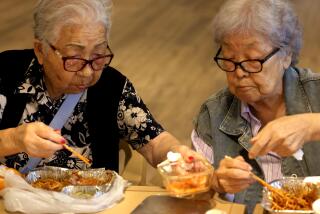Getting to the Heart of Japanese Dance
- Share via
It’s been a kinetic summer for Madam Chiseye Fujima, the official choreographer of Nisei Week, Little Tokyo’s festival honoring second-generation Japanese Americans. After weeks of rehearsal, the 85-year-old grandmother led scores of kimono-clad dancers through two elaborate Ondo folk dances during the August celebration.
Fujima has natori (professional) status in the classical art of Nihon Buyo, which is often referred to as Kabuki-style dance. A native of Hawaii, Fujima (after the Tokyo school where she earned her title) has been teaching dance for more than 60 years, 40 in Los Angeles. We spoke with the sensei at her Gardena home before Nisei Week.
What’s being expressed in a classical dance piece?
Our dances are just like theater, so every number tells a story. It could be anything from changing of the seasons, to being a housewife or geisha. The geisha could be a young girl going out to meet her patrons, or an older geisha reminiscing.
How do you distinguish one character from another?
We’re not actors, so we can’t just cry to show that we’re sad. We have to display feelings through very subtle head movements, hand gestures and whatnot. The movements vary for different emotions, [and] for every character, too. For example, your hands should be lower when portraying an older woman. You would never do that when playing a young girl or princess.
What makes Japanese dance a classical art?
The stage is considered a religious space. People don’t walk around in the same stockings they’ve been in all day. A program always begins with a ritual dance that welcomes the gods to the space. But Japanese dance is also aesthetically beautiful. I love the lines, the flowing movements. The transitions are so graceful.
This tradition doesn’t seem to be limited to the young.
Older dancers bring insight. With ballet and Western dance, you try to defy gravity with leaps and bounds; Japanese dance, on the other hand, is about pulling down, becoming connected to the earth. So that opens the window of opportunity more.
Why study this art form today?
It’s just like playing the piano or studying ballet. You learn discipline and gain confidence. But you are taking part in something that your ancestors participated in hundreds of years ago. Kabuki dates to the 1600s. You have to be born into a Kabuki family to be a Kabuki actor, but anyone can learn their style of dancing.
What qualities does a dancer need?
A unique thing about Japanese dance is that you don’t have to be born with a certain body type. You work with what you have. But you must have dedication. It’s a lifetime commitment.
Any good candidates at Nisei Week rehearsals?
Oh, yeah. But they’ll have to study to become great.
More to Read
The biggest entertainment stories
Get our big stories about Hollywood, film, television, music, arts, culture and more right in your inbox as soon as they publish.
You may occasionally receive promotional content from the Los Angeles Times.










